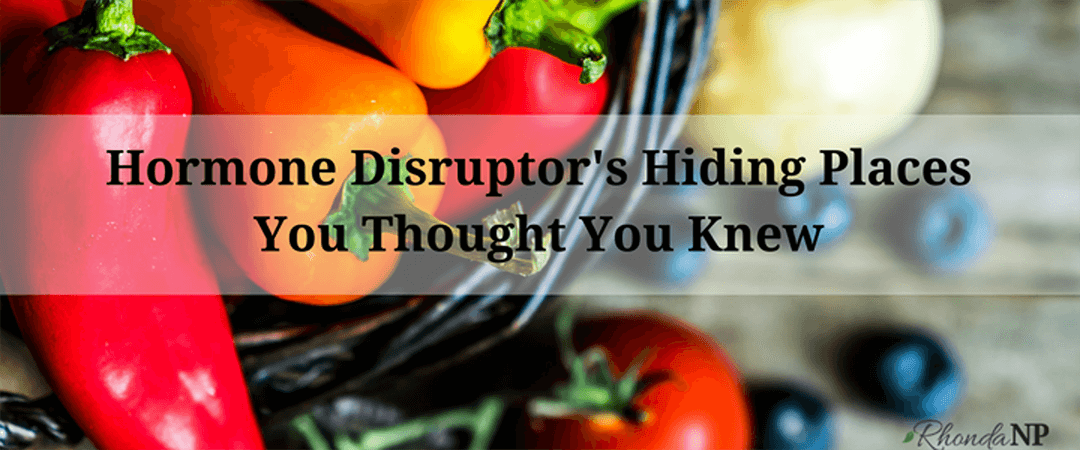Hormone Disruptors and Menopause
Hormone disruptors (also sometimes called endocrine disruptors) are chemicals that may interfere with your body’s endocrine system and produce negative developmental, reproductive, neurological, and immune effects. Attention, perimenopausal and menopausal women… avoid hormone disruptors! You’ve got enough going on right now.
Our endocrine system is a beautiful symphony where everything is balanced and linked. In perimenopause and menopause, this symphony starts to get a little out of tune. Hormone disruptors cause even more interference because they mimic the effects of true estrogen, linking to receptor sites and contributing to estrogen excess or they may block the effects of true estrogen.
Toxins exist everywhere in our lives today. Hormone disruptors gain entry to your body through our food by way of pesticides. Nearly three-fourths of the 6,953 produce samples tested by the U.S. Department of Agriculture in 2014 contained pesticide residues – a surprising finding in the face of soaring consumer demand for food without synthetic chemicals. (1) Even though consumers vote with their pocketbooks for produce with fewer pesticides, sometimes it is difficult to locate or expensive.
One way to protect against hormone disruptors is to educate yourself when shopping for healthy meals. The Environmental Working Group creates a yearly nifty guide called the “Clean 15 and the Dirty 12” that ranks pesticide contamination on 48 popular fruits and vegetables.
Here are the 2016 results:
Clean 15
- Avocados
- Corn
- Pineapples
- Cabbage
- Sweet Peas
- Onions
- Asparagus
- Mangoes
- Papayas
- Kiwi
- Eggplant
- Honeydew
- Grapefruit
- Cantaloupe
- Cauliflower
Dirty 12
- Strawberries
- Apples
- Nectarines
- Peaches
- Celery
- Grapes
- Cherries
- Spinach
- Tomatoes
- Bell Peppers
- Cherry Tomatoes
- Cucumbers
Do these results mean you shouldn’t eat more fruits and vegetables? Really? Of course not! The benefits of nutrient-rich fruits and vegetables far outweigh the risks of pesticide exposure. Of course, you can eat items from the “Dirty 12” as they are much better for you than unhealthy additive-laden processed foods. Follow these tips a bit closer with the Dirty 12.
Tips to Avoid Hormone Disruptors in your food
Buy Organic – whenever possible, buy organic. It reduces your exposure to pesticides. The added benefit is that it sends a message that you believe in environmentally-friendly practices that protect water quality, wildlife, soil, and worker safety. “Organic” is a designation used by the U.S. Department of Agriculture National Organic Program to certify food that was produced without synthetic chemicals or fertilizers, genetic engineering, radiation, or sewage sludge. (2)
Buy Local – farmer’s markets showcase the bounty of your community. You also have the opportunity to speak directly to the farmer/grower to ask any specific questions about their products and what, if any, pesticides are used. They’re often a safer bet even if they haven’t been certified organic. Even though the toxin DDT was banned as a pesticide in the US in 1972 (3), we still produce it and sell it to other countries. Much of the produce on our supermarket shelves comes from overseas.
Grow your Own – take it from the National Gardening Association or even a vintage Martha Stewart article… you can do this! Also, we believe menopause is a time of personal creativity so taking on new things like gardening can be super fulfilling for both your mind and body.
Buy “American Grass-fed” animal products – grass-fed animals are those that have eaten nothing but grass and forage from weaning to harvest, have not been raised in confinement, and have never been fed antibiotics or growth hormones. (4)
Action Steps:
- Pay attention to what you are putting in your body. It’s always mattered but now in perimenopause and menopause, there are additional factors to consider. Sneaky hormone disruptors are hiding everywhere!
- Consider your own garden (see above). Or try on a sample project by growing your own kitchen herb garden.
Sources
https://www.ewg.org/foodnews/summary.php
https://www.ewg.org/foodnews/faq.php#question_3
https://www.epa.gov/ingredients-used-pesticide-products/ddt-brief-history-and-status
http://www.americangrassfed.org/


